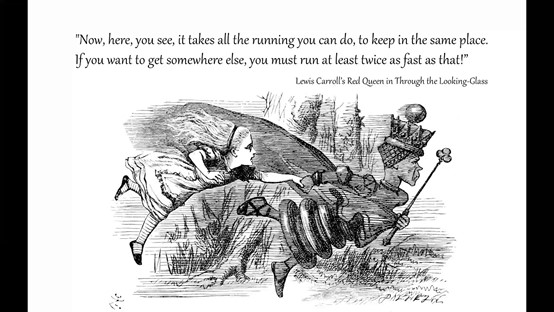
Race to the top: Mastering the art of strategic imitation can be a powerful driver for growth
They say imitation is the sincerest form of flattery. In business, imitation is a powerful and prevalent strategic move.
Yet it's often viewed as a threat rather than a dignified element of strategy.
As the economist Theodore Levitt astutely noted in 1966: “Imitation is not only more abundant than innovation, but actually a much more prevalent road to business growth and profits.”
Recent research supports this view. Imitation is increasingly recognised as a key source of dynamic capabilities and innovation, which can potentially lead to competitive advantage.
However, the conventional wisdom about imitation is often misguided.
Common misconceptions include the notions that imitation is easy and that only weak firms imitate. Alternatively, critics conclude that uncertainty promotes imitation, or that there's only one imitation strategy. These myths oversimplify a complex strategic tool.
There are three factors any business must consider when imitating strategic innovation by a potential competitor.
1 Speed
In a recent article we highlighted the importance of speed when imitating an innovation by a rival. In a study of UK mobile phone companies, we showed empirically that a firm’s imitation speed influences its performance.
The advantages of rapidly imitating innovation are especially strong in industries where first adopters of new product technologies benefit from 'spatial preemption' - a strategic concept where a firm creates barriers to entry into the market for any competitors. Thus, speedy imitation allows them to fill product differentiation niches before late adopters enter the market.
Speed also affects consumer perception. Firms that quickly adopt new technologies are seen as more innovative. This creates a 'halo effect' that boosts sales across their product lines. Therefore, rapid imitation can neutralise the advantage often enjoyed by a competitor that makes the first move.
As Levitt pointed out: “There is usually a great premium on speed. One wants not just to catch up quickly with the successful innovator but, more particularly, to do so faster than other would-be imitators who are also working against the clock.”
However, fast imitation can trigger escalating rivalries. This can lead to fierce competition as firms strive to outpace one another in responding to innovations.
When Nokia introduced cutting-edge mobile technologies in the 1990s, Siemens was quick to imitate, maintaining competitiveness in the market. But as more rivals imitated these innovations, the pace of technological evolution in the industry accelerated. This pushed all competitors to adapt quickly or fall behind.
2 Choosing Your Target
Who you imitate is crucial. Imitating the market leader can be a risky strategy. Leaders often have the resources and motivation to retaliate against imitators.
After the success of the Apple iPad in the early 2010s, the company aggressively pursued lawsuits against imitators. This lead to bans on competing products in several countries. That damaged the performance of those firms who tried to imitate Apple’s technology.
A market leader’s response will usually be more intense than that of their rivals who do not occupy such a strong position. That makes it crucial for firms to weigh the risks of provoking a stronger competitor before they decide who to imitate.
3 Timing Is Everything
Deciding when to imitate a rival is just as important as deciding who to imitate.
The 'clockspeed' of an industry - how quickly it evolves - is a crucial contingency.
In fast-moving industries, rapid imitation can lead to what is known as the 'Red Queen' effect. The name is a reference to a line from Lewis Carroll’s tale, Alice Through the Looking Glass. In the book, the Red Queen tells Alice: “It takes all the running you can do to keep in the same place.”

Industries often exhibit similar dynamics. Firms must continually adapt to survive, facing ever-evolving competitors in a constantly changing environment.
This relentless drive to maintain relative fitness in a dynamic system means that companies often improve as quickly as possible just to stay on par with their rivals.
This constant adaptation can enhance short-term competitiveness and offer protection against strong retaliation by competitors. However, it may also diminish a firm’s ability to manage major transitions.
Nokia’s shift in strategy during the early 2000s offers a cautionary example. As the mobile phone industry’s clockspeed increased, Nokia slowed its competitive behavior. The firm preferred to wait for technologies to stabilise before fully committing.
This approach allowed rivals like Samsung and Sony Ericsson to capitalise on the latest innovations and gain an edge in the market.
How imitation has driven technological progress
Imitation has been crucial in technological advancement throughout history.
We can certainly see how speedy imitation has been present in different forms along history.
A 'fast second' strategy involves quickly following a pioneer before they establish a monopoly. This approach requires highly developed imitation competencies, from superior referencing, searching, and spotting, to implementation, as well as an infrastructure for conducting reverse engineering.
In industries like household and personal care products, manufacturing capabilities are essential for private-label producers. These are often dominated by large firms such as Procter & Gamble.
Latecomers need to enter the market later due to barriers or opportune timing. However, this allows them time to differentiate their products through their quality, price, or appearance.
In 18th century Britain, imitating foreign luxuries inspired firms to develop new commodities such as iron suspension bridges and porcelain.
These historical lessons are still relevant today. As a senior executive at a large retailer said: “Our policy is to never be the first to try something new; we will only consider the tried and true.”
This cautious approach highlights the complexities of an imitation strategy. By learning from history, businesses can better decide when and whom to imitate, and how quickly to do so, in order to achieve success.
Why strategic imitation is not just about copying
As we look to the future, it is crucial to recognise the role of imitation in business strategy. Imitation is not just about copying; it is about creating capabilities and learning to dance with competitors.
Successful firms use imitation as a tool for growth and innovation. They understand that imitation can lead to unique adaptations and improvements.
In conclusion, imitation is a nuanced and powerful strategic tool. It's not simply about being first or last, fastest or slowest.
The key lies in understanding your industry, your competitors, and your own capabilities. By mastering the art of strategic imitation, businesses can turn a seemingly simple act of copying into a powerful driver of innovation and growth.
Further reading:
How can an SME out-innovate bigger companies?
Four keys to use big data to unlock better strategy
How to build a resilient organisation
Catching up with the market leader: Does it pay to rapidly imitate its innovations?
Stefano Li Pira is Associate Professor of Strategy and International Business at Warwick Business School. He teaches Strategic Advantage and Leading Organisations: Performance, Stakeholders, and Governance on the Global Online MBA, Executive MBA, and Executive MBA (London).
Learn more about gaining a competitive advantage on the four-day Executive Education course Strategic Choices at WBS London at The Shard.
For more articles on Strategy and Organisational Change sign up to Core Insights.




 X
X Facebook
Facebook LinkedIn
LinkedIn YouTube
YouTube Instagram
Instagram Tiktok
Tiktok